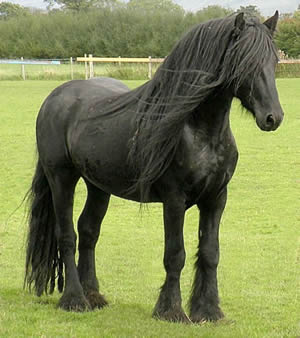General Description
Black, brown, bay and grey. Chesnuts, piebalds and skewbalds are debarred. A star and/or a little white on or below the hind fetlock is acceptable. An excess of white markings is discouraged, but such ponies are eligible for registration.
Head: Small, well chiselled in outline, well set on, forehead broad, tapering to nose.
Nostrils: Large and expanding.
Eyes: Prominent, bright, mild and intelligent.
Ears: Neatly set, well formed and small.
Throat and Jaw: Fine, showing no signs of throatiness nor coarseness.
Neck: Of proportionate length, giving good length of rein, b and not too heavy, moderate crest in case of stallion.
Shouders: Most important, well laid back and sloping, not too fine at withers, nor loaded at the points - a good long shoulder blade, muscles well developed.
Carcass: Good back of outline, muscular loins, deep carcase, thick through heart, round ribbed from shoulders to flank, short and well coupled, hind quarters square and b with tail well set on.
Feet, Legs and Joints: Feet of good size, round and well formed, open at heels with the characteristic blue horn, fair sloping pasterns not too long, forelegs should be straight, well placed not tied at elbows, big well formed knees, short cannon bone, plenty of good flat bone below knee (eight inches at least), great muscularity of arm.
Hind Legs: Good thighs and second thighs, very muscular, hocks well let down and clean cut, plenty of bone below joint, hocks should not be sickle nor cow-hocked.
Mane, Tail, and Feather: Plenty of fine hair at heels (coarse hair objectionable), all the fine hair except that at point of heel may be cast in summer. Mane and tail are left to grow long.
Action: Walk, smart and true. Trot well balanced all round, with good knee and hock action, going well from the shoulder and flexing the hocks, not going too wide nor near behind. Should show great pace and endurance, bringing the hind legs well under the body when going.
General Character: The Fell Pony should be constitutionally as hard as iron and show good pony characteristics with the unmistakable appearance of hardiness peculiar to mountain ponies, and at the same time, have a lively and alert appearance and great bone.






